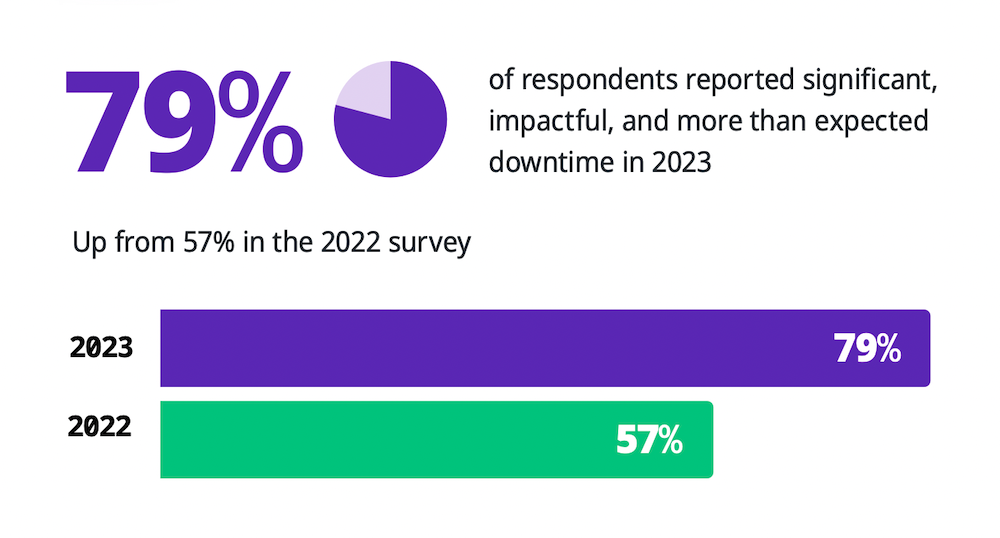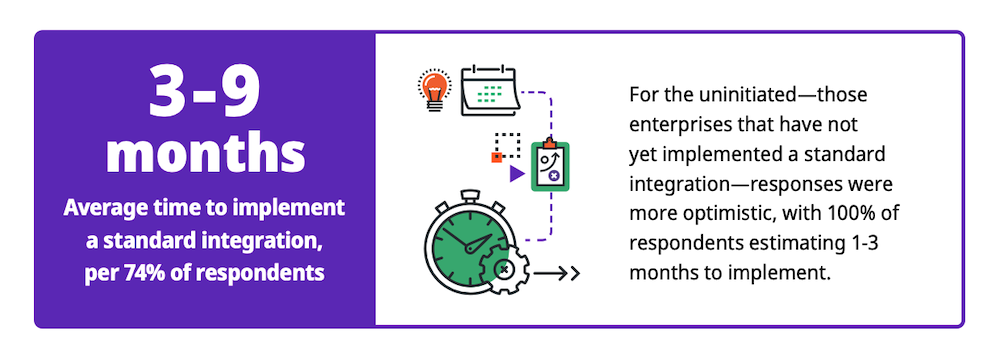May 9, 2023
Em 2023, a Digibee realizou nosso segundo Pesquisa de integração do estado da empresa, alcançando mil CTOs, CIOs, arquitetos de sistema e desenvolvedores da Web na América do Norte.
Em cada postagem de blog desta série, examinamos uma das principais descobertas do relatório, identificada por seus colegas. Hoje nos aprofundamos no impacto do tempo de inatividade do sistema ao implementar uma plataforma de integração.
O desafio: tempo de inatividade do sistema
O que é pior do que lidar com os desafios da transformação digital de sistemas legados, mudanças de prioridades, problemas de comunicação interdepartamental e recursos inadequados? Tempo de inatividade do sistema.

no Digibee’s Relatório – 2023 State of Enterprise Integration nossos entrevistados relataram um aumento acentuado no tempo de inatividade do sistema que foi significativo, impactante e mais do que o esperado quando comparado aos dados da pesquisa de 2022. Muitos problemas de TI contribuem para a duração e a gravidade do tempo de inatividade de um sistema, desde a dependência de tecnologia de integração desatualizada que pode ser executada internamente, no local ou usando sistemas legados, até a falta de monitoramento ou um processo de implantação lento e ineficiente.
 Quando os sistemas falham… os custos aumentam
Quando os sistemas falham… os custos aumentam
A transformação digital bem-sucedida depende da construção de um sistema que seja tão confiável quanto rápido. Cada vez que um sistema passa por um período de inatividade, o negócio sofre um impacto financeiro significativo. Dessa forma, uma integração não confiável pode custar mais dinheiro à empresa do que economizar por meio de outras eficiências.
O custo do tempo de inatividade aumentou significativamente para 90% das PMEs e grandes empresas, com 44% relatando que uma única hora de tempo de inatividade poderia custar mais de US$ 1 milhão.
– Consultoria em Inteligência de Tecnologia da Informação, Custo por hora de tempo de inatividade, 2022
O custo financeiro pode assumir várias formas, durante o processo de integração e após a implantação da nova integração, incluindo:
Cronogramas de integração inchados
No início da integração, um objetivo comercial comum é acelerar a transformação digital o máximo possível. Quando questionados sobre quanto tempo eles acreditavam que sua integração levaria, nosso Relatório – 2023 State of Enterprise Integration descobriu que aqueles que estão começando sua jornada de integração estimam de 1 a 3 meses. Em contraste, aqueles que concluíram uma integração padrão relataram que demorou de 3 a 9 meses; um aumento de 300%! Isso é uma degradação séria do otimismo para aqueles que aparentemente aprenderam da maneira mais difícil.
Embora o tempo de inatividade de TI não seja a causa principal da disparidade do cronograma, o tempo de inatividade que ocorre durante a fase de implementação pode facilmente se tornar um dos principais contribuintes para a erosão dos cronogramas, especialmente com uma equipe interna inexperiente (ou com falta de pessoal). Isso acontece ao complicar o ciclo de feedback vital das integrações de teste, pois os desenvolvedores são forçados a procurar a origem de cada falha e corrigi-la.
E lembre-se, onde os cronogramas de integração se estendem, os custos também se expandem para o resto do negócio. No mínimo, a empresa deve manter seu antigo sistema ineficiente por mais tempo. Pior cenário: o tempo de inatividade da TI também afeta os principais sistemas de negócios.
Quanto tempo sua equipe leva para implementar uma integração padrão?
Incapacidade de realizar transações comerciais
Depois que sua integração estiver ativa, você pode sentir que sua jornada de integração acabou. Infelizmente, problemas de desempenho surgem quando implantados no mundo real, quando as integrações (e todos os serviços aos quais se conectam) precisam ser dimensionadas para acomodar os horários de pico. É claro que, se o teste de desenvolvimento de integração original também resultou em uma colcha de retalhos de correções, esses patches permanecerão como pontos fracos no sistema.
Não é preciso muita imaginação para imaginar como o tempo de inatividade do sistema devido a integrações ao vivo custa dinheiro para os negócios: impedindo que os clientes acessem serviços ou produtos. Por exemplo, se a integração de um sistema POS com um provedor de pagamento cair, seu cliente agora precisa ter dinheiro em mãos ou não pode comprar seus produtos ou serviços. Se sua interrupção for com sua plataforma de comércio eletrônico, seu cliente pode ficar sem opções de compra.
A única coisa que continua são suas despesas gerais, com vendedores ociosos, estoque parado e suas despesas operacionais continuando a acumular.
Satisfação e Reputação do Cliente
Sua capacidade de satisfazer seus clientes representa um problema distintamente diferente, mas igualmente caro: um golpe em sua reputação profissional significa uma perda incalculável em vendas futuras.
Quer você seja um provedor de serviços cujo tempo de inatividade de TI derrubou o site do seu cliente (também… olá, multas de SLA!), e experiência benéfica. E, assim como os clientes satisfeitos, os clientes insatisfeitos contam aos amigos.
Transformação digital bem-sucedida com iPaaS
3 benefícios de usar iPaaS da Digibee para sua transformação digital
Seja reconstruindo integrações anteriores ou começando do zero, o iPaaS influencia fortemente em sua jornada de transformação digital. Uma estratégia bem-sucedida é bem pensada, minimizando o tempo de inatividade do sistema e fornecendo planos de contingência para interrupções inesperadas durante a integração, implantação e além. O iPaaS da Digibee é uma parte inestimável do plano, fornecendo experiência e resiliência em:
1. Acelerando as Integrações do Sistema
O Digibee mitiga o risco de inatividade do sistema durante a implementação da integração acelerando a transformação digital, mantendo o período de transição curto e bem definido. Aproveitar as cápsulas reutilizáveis da Digibee torna mais fácil alavancar soluções prontas para uso ou modificá-las conforme necessário.
A tecnologia é mais rápida e muito menos propensa a erros em comparação com a criação de todas as integrações do zero, e a curva de aprendizado de TI é mínima com o Digibee’s Integração do cliente em três etapas de suporte.
2. Reduzindo o tempo de inatividade durante a implantação da integração
O tempo de inatividade geralmente ocorre durante a implementação, interrompendo os negócios e expondo os clientes a uma experiência negativa.
O iPaaS da Digibee minimiza – e muitas vezes elimina – o tempo de inatividade, executando o novo sistema em conjunto com o sistema legado para uma transição perfeita. Nossa plataforma gerencia ambientes de desenvolvimento, teste e produção por meio de DevOps e inclui um sistema totalmente automatizado pipeline processo de implantação e publicação. Essa simultaneidade elimina o risco e a preocupação quando chegar a hora de mudar a chave.
3. Manutenção de TI e Medidas Preventivas
Assim que a integração estiver instalada e funcionando, o iPaaS da Digibee mantém tudo funcionando perfeitamente. Cada pipeline na implementação é completamente isolado dentro de uma infraestrutura Kubernetes, otimizada para cada caso de uso específico. Falha de um pipeline não afeta a execução de outra, e uma nova instância pode ser iniciada em menos de um segundo, reduzindo drasticamente o tempo de inatividade do sistema e outros problemas de TI.
Valiosas medidas preventivas, como sistemas de segurança configuráveis, monitoramento 24 horas por dia, 7 dias por semana e tratamento simplificado de erros, permitem que a empresa reaja imediatamente ao primeiro sinal de problema, antes que possam ocorrer interrupções.
Com tantos desafios a serem superados, não é surpresa que mais de 70% dos líderes entrevistados estejam planejando ativamente adotar, complementar ou substituir sua tecnologia de integração em 2023.
Saiba como a Digibee pode ajudar
Obtenha a história completa sobre o que mudou e como seus colegas estão mobilizando a integração empresarial em 2023. Faça o download gratuito do relatório Digibee 2023 State of Enterprise Integration hoje para todos os resultados da pesquisa e a análise.








